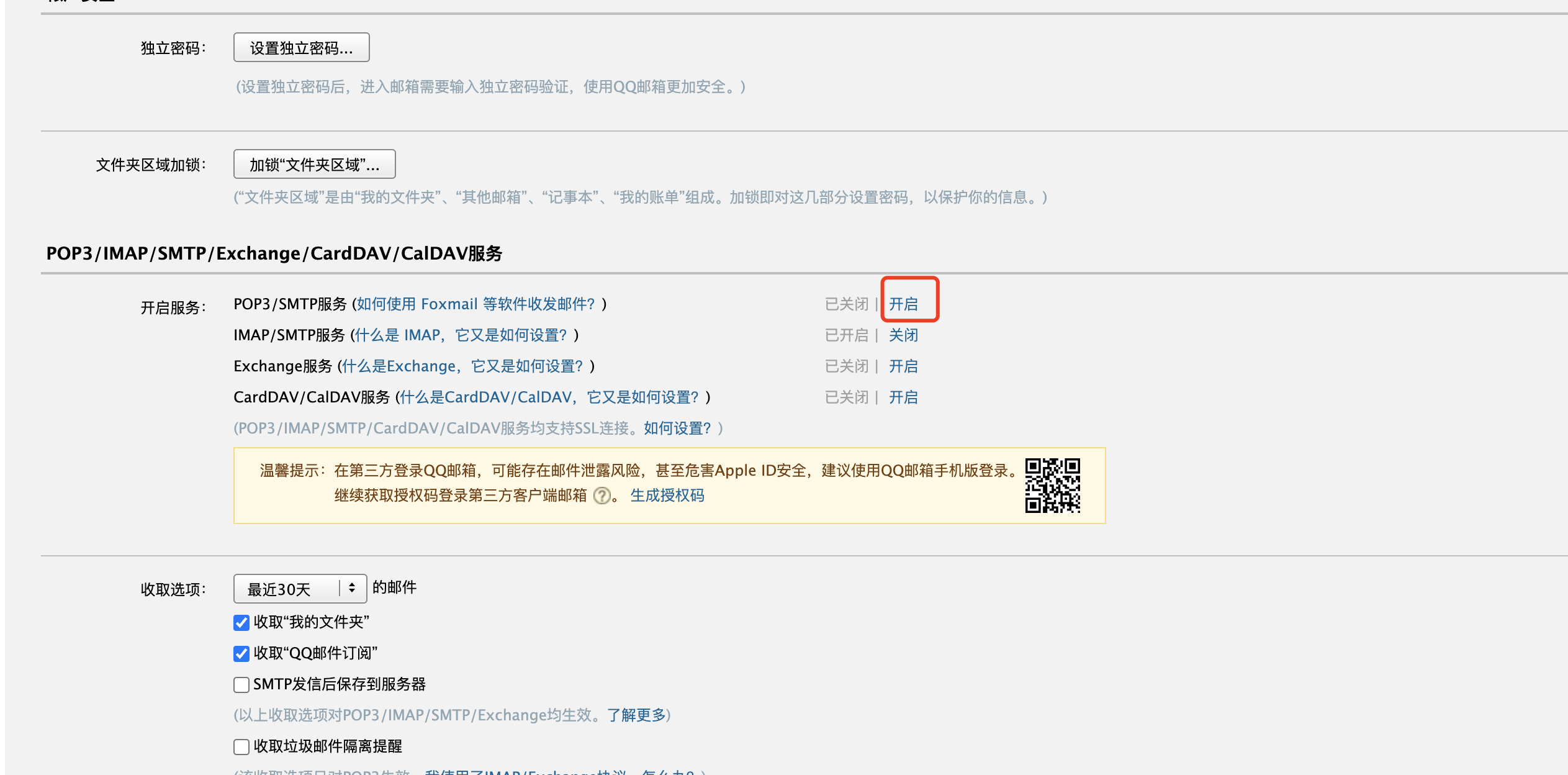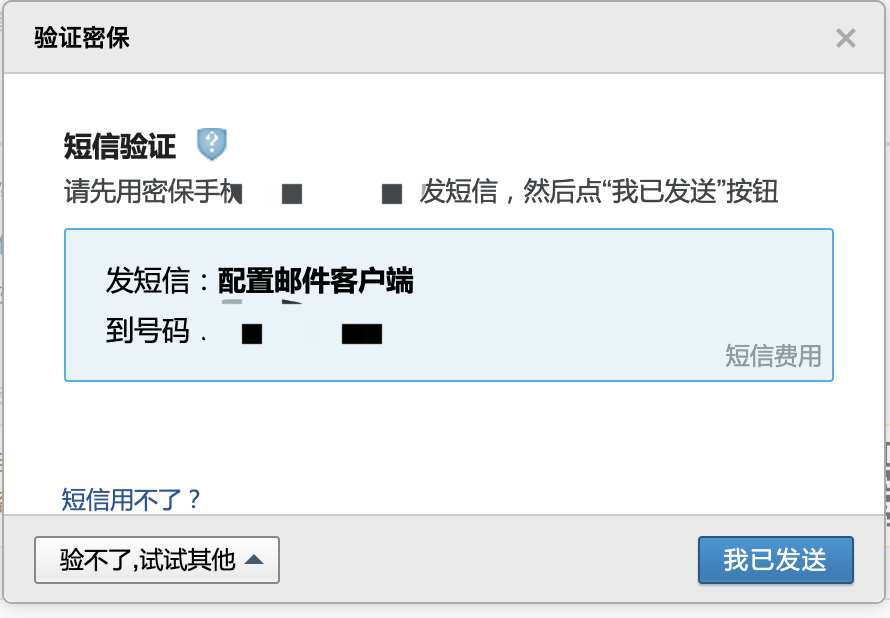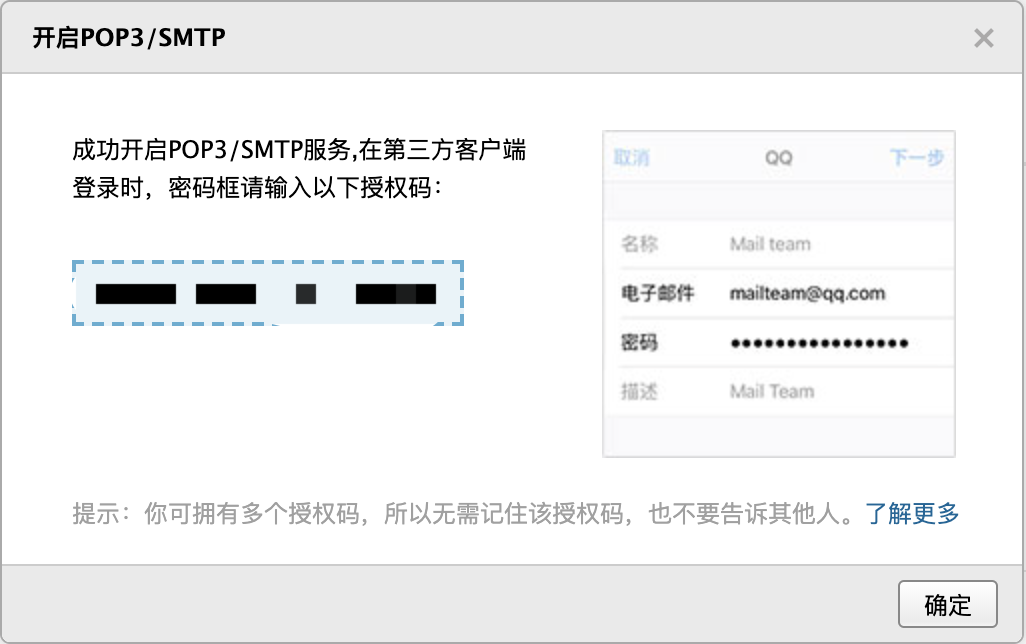Code execution + failure rerun of TestNg of SpringBoot
My design idea is to directly add the corresponding Controller layer and service layer in SpringBoot, and directly encapsulate the run and failure rerun into interfaces. In fact, the Controller layer to realize the call is only a way and an exit. The important thing is the design of the implementation layer, which is blood and meat.
Design ideas
1. Implement an interface that runs all use cases
2. Implement an interface for running failure cases
3. Now that we have executed the use case and want to see the results, we will receive the results by mail
Mail sending function
Add JavaMail API
Address: Portal
Add it to the pom file
Start smtp service on QQ




Remember this authorization code
Realize the function of sending mail
This paragraph is the function of the boss I copied. I just put it in SpringBoot
package com.newcrud.utils;
import org.springframework.stereotype.Component;
import org.springframework.stereotype.Service;
import javax.activation.DataHandler;
import javax.activation.DataSource;
import javax.activation.FileDataSource;
import javax.mail.*;
import javax.mail.internet.InternetAddress;
import javax.mail.internet.MimeBodyPart;
import javax.mail.internet.MimeMessage;
import javax.mail.internet.MimeMultipart;
import java.util.Properties;
@Component
public class SendMail {
public void sendMail(){
// Create a Property file object
Properties props = new Properties();
// Set the information of the mail server. Set the smtp host name here
props.put("mail.smtp.host", "smtp.qq.com");
// Set the port of socket factory
props.put("mail.smtp.socketFactory.port", "465");
// Set socket factory
props.put("mail.smtp.socketFactory.class","javax.net.ssl.SSLSocketFactory");
// Setting requires authentication
props.put("mail.smtp.auth", "true");
// Set the SMTP port. The SMTP port of QQ is 25
props.put("mail.smtp.port", "25");
// Authentication implementation
Session session = Session.getDefaultInstance(props, new javax.mail.Authenticator() {
protected PasswordAuthentication getPasswordAuthentication() {
// The second parameter is the authorization code for QQ to open smtp
return new PasswordAuthentication("xxxxx@qq.com", "indwjcbpfwrbbebf");
}
});
try {
// Create an instance object of the MimeMessage class
Message message = new MimeMessage(session);
// Set sender email address
message.setFrom(new InternetAddress("xxxx@qq.com"));
// Set recipient email address
message.setRecipients(Message.RecipientType.TO,InternetAddress.parse("xxx@xxx.com"));
// Set message subject
message.setSubject("Unit test send mail");
// Create an object of MimeBodyPart to add content
BodyPart messageBodyPart1 = new MimeBodyPart();
// Set message body content
messageBodyPart1.setText("This is the body of the message");
// Create another MimeBodyPart object to add additional content
MimeBodyPart messageBodyPart2 = new MimeBodyPart();
// Set the path of the attachment file in the message
String filename = "test-output/emailable-report.html";
// Create a datasource object and pass the file
DataSource source = new FileDataSource(filename);
// Set handler
messageBodyPart2.setDataHandler(new DataHandler(source));
// load file
messageBodyPart2.setFileName(filename);
// Create an instance object of the MimeMultipart class
Multipart multipart = new MimeMultipart();
// Add body 1 content
multipart.addBodyPart(messageBodyPart1);
// Add body 2 content
multipart.addBodyPart(messageBodyPart2);
// Set content
message.setContent(multipart);
// Final send mail
Transport.send(message);
System.out.println("=====The message has been sent=====");
} catch (MessagingException e) {
throw new RuntimeException(e);
}
}
}
Let's test whether the function is normal. I have executed the xml file once and generated the corresponding out put folder
package com.newcrud.utils;
import org.springframework.beans.factory.annotation.Autowired;
import org.springframework.boot.test.context.SpringBootTest;
import org.springframework.test.context.testng.AbstractTestNGSpringContextTests;
import org.testng.annotations.Test;
@SpringBootTest
public class SendMailTest extends AbstractTestNGSpringContextTests {
@Autowired
SendMail sendMail;
@Test
public void testSendMail() {
sendMail.sendMail();
}
}
After execution, the mail is received normally, indicating that the function is normal.
Implement all and failed test cases
Interface
package com.newcrud.service;
public interface TestNgRunService {
void runAll();
void runFail();
}
Implementation class
package com.newcrud.service.impl;
import com.newcrud.service.TestNgRunService;
import org.apache.tomcat.jni.Time;
import org.springframework.stereotype.Service;
import org.testng.TestNG;
import java.util.ArrayList;
import java.util.List;
@Service
public class TestNgRunServiceImpl implements TestNgRunService {
@Override
public void runAll() {
TestNG testNone=new TestNG();
List<String> list=new ArrayList<>();
list.add("testng.xml");
testNone.setTestSuites(list);
testNone.run();
}
@Override
public void runFail() {
TestNG testNTwo = new TestNG();
List<String> list=new ArrayList<>();
list.add("test-output/testng-failed.xml");
testNTwo.setTestSuites(list);
testNTwo.run();
}
}
Execution class
package com.newcrud.service.impl;
import com.newcrud.utils.SendMail;
import org.springframework.beans.factory.annotation.Autowired;
import org.springframework.boot.test.context.SpringBootTest;
import org.springframework.test.context.testng.AbstractTestNGSpringContextTests;
import org.testng.annotations.Test;
import static org.testng.Assert.*;
@SpringBootTest
public class TestNgRunServiceImplTest extends AbstractTestNGSpringContextTests {
@Autowired
TestNgRunServiceImpl testNgRunService;
@Autowired
SendMail sendMail;
@Test
public void testRunAll() {
testNgRunService.runAll();
sendMail.sendMail();
}
@Test
public void testRunFail() {
testNgRunService.runFail();
sendMail.sendMail();
}
}
Test it
Test class A
package com.newcrud.testngTest;
import org.testng.Assert;
import org.testng.annotations.Test;
public class TestFour {
@Test
public void testA() {
System.out.println("testA");
Assert.assertEquals(1,2);
}
@Test
public void testB(){
System.out.println("testB");
Assert.assertEquals(1,1);
}
}
Test class B
package com.newcrud.testngTest;
import org.testng.Assert;
import org.testng.annotations.Test;
public class TestThree {
@Test
public void testA(){
System.out.println("testA");
Assert.assertEquals(1,2);
}
@Test
public void testB(){
System.out.println("testB");
Assert.assertEquals(1,1);
}
}
xml file
<?xml version="1.0" encoding="UTF-8"?>
<!DOCTYPE suite SYSTEM "http://testng.org/testng-1.0.dtd">
<suite name="All Test Suite">
<test verbose="2" name="/Users/zc/IdeaProjects/NewCRUD/src/test/java/com/newcrud" time-out="3000">
<classes>
<class name="com.newcrud.testngTest.TestThree"></class>
<class name="com.newcrud.testngTest.TestFour"></class>
</classes>
</test>
</suite>
In the future, you can directly execute the execution class TestNgRunServiceImplTest on the IDEA. After each execution, the corresponding e-mail will be sent.
People who saw it must be very puzzled. Why did I write the implementation class @Service? Because what I want to achieve is calling through the interface. Unfortunately, I failed, so I deleted the Controller, and it was good. But after calling SpringBoot, it would be too difficult to find the corresponding test class in xml. So that's it. For the time being, I'm tired